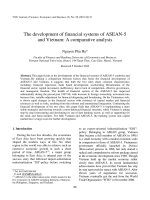History - fundamental - development of CT system
Bạn đang xem bản rút gọn của tài liệu. Xem và tải ngay bản đầy đủ của tài liệu tại đây (1.3 MB, 17 trang )
DR. NGUYEN XUAN THUC
1972 – First clinical CT scanner
- Used for head examinations
-80 x 80 matrix
-4minutes for each scan
-8 levels of grey
-overnight image reconstruction
The first clinical scan
1
st
Oct, 1971
Nobel man (1979 Nobel Prize in Physiology
and Medicine.) Godfrey Hounsfield with an
early version of the CT scanner - 1972
The first clinical CT scanners were
installed between 1974 and 1976. The
original systems were dedicated to head
imaging only
2004 – 64 slice CT scanner
- Used for whole body
-1024 x 1024 matrix
-0,33s per revolution
-64 images per revolution
-overnight image reconstruction
-0.4mm slice thickness
-20 images reconstructed/second
Present-day
PHILIPS 256
SIEMEN 256
TOSHIBA 320
(HOUNSFIELD/UNIT)
CT NUMBERS FOR VARIOUS BODY TISSUES
(HOUNSFIELD/UNIT)
PARTIAL VOLUME EFFECT ON CT
S- 1
S- 2
S- 3
S- 6
S- 7
Hemorrhage?
Unenhanced CT image shows
a 1-cm lesion isodense
partially intraparenchymal
lesion measuring 20 HU.
Nephrographic phase
Enhanced attenuation was 50 HU
(pseudoenhancement 30
HU).Lesion revealed a cystic
pattern on US and was stable for
morethan 3 years on CT follow-up
Different windowing in CT allows optional evaluation of
each organs; e.g subdural window (for subdural blood),
brain window (for brain parenchyma), bone window (for
bone), etc
subdural window
bone window brain window
Types of iodinated contrast
- Ionic
- Nonionic
(No change in death rate from reaction
but number of reactions is decreased by
factor of 4 to compare with ionic).
1 Chest x ray approximates the same risk as:
- 1 year watching TV
- 1 coast to coast airplane flight
1 Head CT is approximately 20 chest x ray









